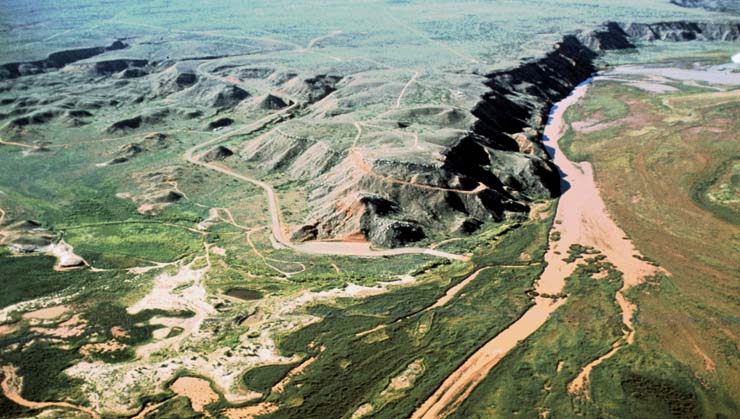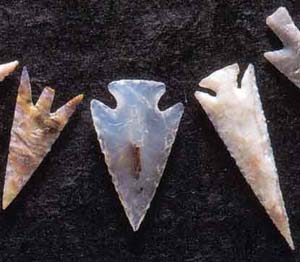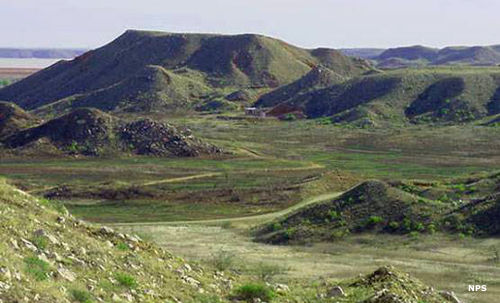Alibates Flint Quarries National Monument

Alibates Flint Quarries National Monument

Alibates flint arrowheads
The Alibates Flint Quarries are located on a series of red bluffs rising above the Canadian River northeast of Amarillo in the panhandle of Texas. The quarries were in use for more than 10,000 years because of the high quality of the rainbow hued volcanic glass found there. That flint was being used by Paleo-American artisans to produce arrowheads and spear points before the Great Lakes were formed. Alibates flint tools and weaponss have been found spread across central North America, from the southwestern deserts to east of the Great Plains, in some cases up to 1,000 miles away. The Clovis People were using Alibates flint to hunt ice age mammoths perhaps 12,000 years ago.
The quarry pits themselves are not very large: maybe 4 to 7 feet deep and between 5 and 25 feet in diameter. The first diggings date back into the major ice ages while the most recent diggings were being worked almost until Christopher Columbus made his first fateful voyage to the New World.
The Antelope Creek people made the biggest impact on the flint quarries, occupying the surrounding area from about 900 CE to about 1450 CE. They lived on terraces overlooking the river and up side canyons where springs could be found. Archaeologists have speculated the Antelope Creek people settled in the area in order to control the lucrative trade in the valuable flint.
The Antelope Creek people appear to have been on the interface between the Plains tribes and the Puebloans of the Rio Grande area as they often built large, masonry, multi-family structures. They also cultivated maize, beans, squash and sunflowers in small, scattered plots but their diet shifted more and more to bison as the population of bison increased dramatically with changes in the climate after about 1000 CE. Exploitation of the bison herds increased further after about 1200 CE and that led to increases in the human population. The human population in the panhandle area reached a pretty high density after 1250 CE with stone building foundations in some areas reaching a density (and layout) similar to that of many modern suburbs. It's estimated that the total population of the panhandle area exceeded 30,000 people with more than 10,000 living in structures along the Canadian River Valley. The water of the Canadian River itself tends to be salty but immediately underground is the Oglalla aquifer. Water from the aquifer emerged in a multitude of springs spread all through the canyons in the area, part of why there were so many small settlements strung out like strings of pearls along the canyon bottoms.
The Antelope Creek people left behind hundreds of settlements, many of which were large stone-slab-and-plaster houses and one-story apartment complexes. Many of their living clusters were separated by two miles or less, often with single farmstead homes (housing up to 15 or 20 people each) in between. Archaeologists speculate they abandoned the area between 1450 and 1500 CE as the climate got drier and agriculture got harder. Some speculations include the fact of increasing hostilities in the area as the Apache moved in and displaced more peaceful tribes. Whatever the reason for their leaving, it seems most of the folks moved to the east and evolved into the Wichita tribe of Kansas and Oklahoma. It also appears that some of the folks moved further east and north and became the Pawnee of the Nebraska area. When Francisco Vasquez de Coronado came into the area looking for the fabled gold of the Seven Cities of Cibola in 1541 all he found were nomadic and semi-nomadic groups of buffalo-hunting natives of Apache and Caddoan lineage.
Today, the Alibates Flint Quarries National Monument is embedded in the Lake Meredith National Recreation Area. The 1,371-acre national monument can be visited only as part of ranger-led tours which must be reserved well in advance.
The name comes from "Allie Bates," a cowboy who lived in the Canadian River Valley in the 1880's.

The mesas and grasslands of Alibates Flint Quarries National Monument